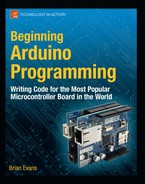Summary
See, that was a lot of fun. In this chapter we looked at a very fundamental—maybe overly abbreviated—sreview of electronics theory and we got a sense for some of the more common types of components and what we might use them for. We also revisited how to read schematics and build prototypes from them using the nifty little gadget called a solderless breadboard. We even tackled how to solder pin headers to breakout boards to make some of the devices we've used more breadboard-friendly.
With that, we have reached the end of our book. By now, you should have a solid foundation of programming Arduino C; you have a working knowledge of how things like control structures, variables, functions, memory, arrays, and libraries are all handled; hopefully, you've been inspired to try out some new project ideas or get involved in the community; and you even have a basic grasp of working with electronic prototypes to make your next projects even easier.
I hope you've enjoyed reading this book as much as I've had writing it and found its content challenging but interesting, useful, and even a little fun too. I look forward to hearing from you and seeing the things that you will make.
